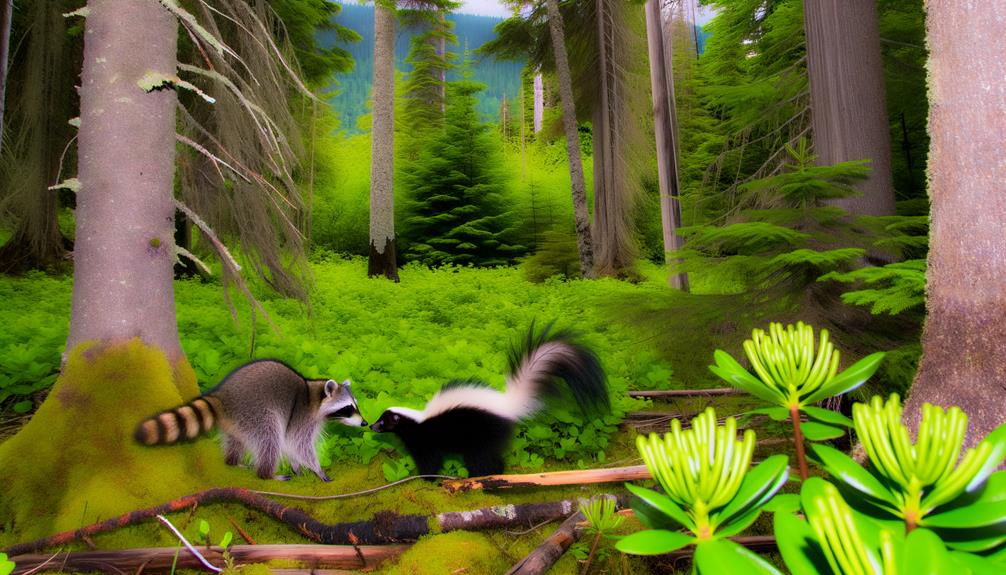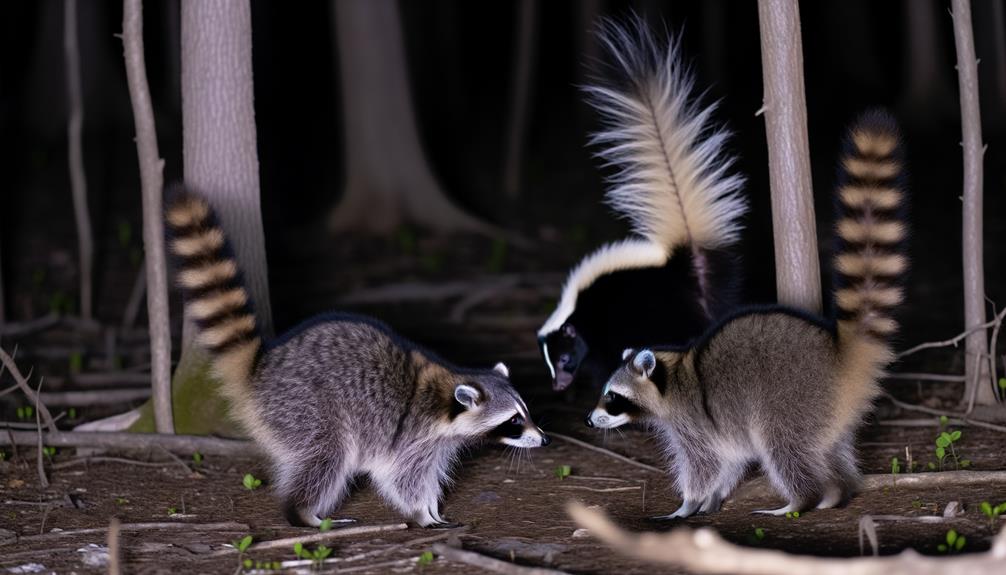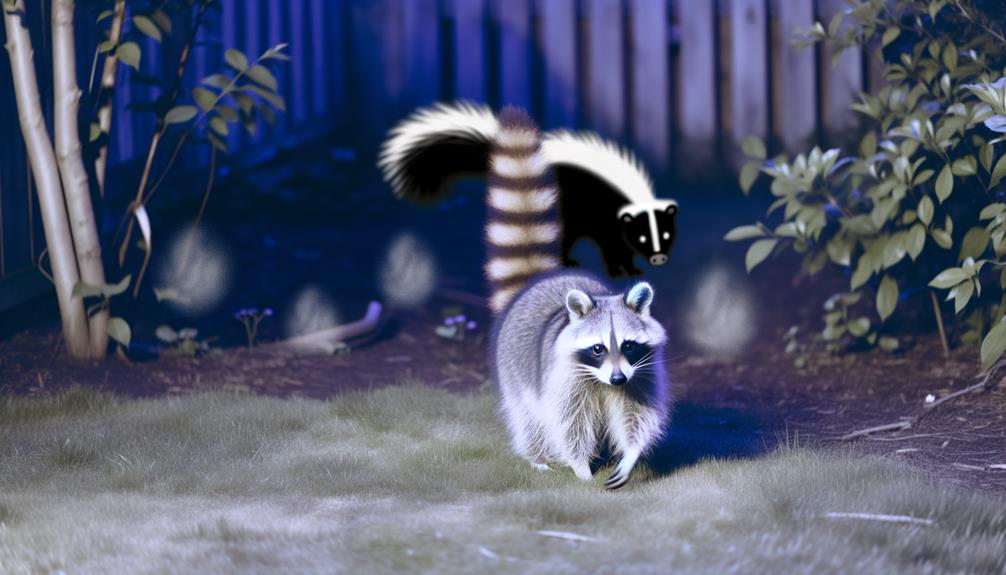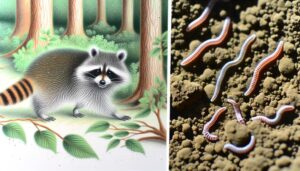Do Raccoons Smell Like Skunks?
Raccoons do not smell like skunks. Raccoons possess scent glands near their tails and feet, which they primarily use for communication and navigation.
These glands secrete pheromones but do not produce a strong, lingering odor. Skunks, on the other hand, have specialized anal glands that secrete thiol compounds, which are highly pungent and used for defense.
This stark difference in the biochemical composition of their secretions means that raccoons do not emit the characteristic foul odor associated with skunks. Exploring these distinctions further reveals the unique biological mechanisms and behaviors of each species within their habitats.

Key Takeaways
- Raccoons do not emit an odor similar to the potent spray of skunks.
- Skunks have specialized anal glands that produce a strong, sulfur-based thiol compound.
- Raccoons have scent glands near their tails and feet, but the odor is less intense.
- Raccoon odors are influenced by diet and habitat rather than defensive mechanisms.
- Proper identification is crucial as raccoon and skunk odors differ significantly.
Raccoon Scent Glands

Raccoons possess specialized scent glands located near the base of their tails and on their feet, which play an integral role in communication and territorial marking. These glands secrete pheromones, which are chemical signals used to convey information to other raccoons.
The scent markings help delineate territory boundaries and identify individual raccoons within a social group. Additionally, the foot glands leave unique scent trails as raccoons walk, providing a way to navigate and establish presence in an area.
The chemical composition of the secretions is complex, consisting of various volatile and non-volatile compounds that can persist in the environment for extended periods. This olfactory communication is vital for social interactions, mating behaviors, and maintaining the hierarchical structure within raccoon populations.
Skunk Odor Mechanism
The skunk odor mechanism primarily involves the secretion of a sulfur-based compound called thiol, which is produced by specialized anal glands. These glands can expel the compound with remarkable accuracy, targeting predators or threats up to ten feet away. Thiols are known for their potent, long-lasting odor, which can linger for days and is challenging to neutralize. The secretion is composed of various chemical constituents, mainly sulfur compounds, which contribute to its distinct and pungent smell.
| Component | Function |
|---|---|
| Thiol | Primary odorant |
| Sulfur compounds | Odor enhancement |
| Anal glands | Secretion production |
| Muscles around glands | Expel secretion accurately |
This defensive mechanism is an evolutionary adaptation that effectively deters predation.
Behavioral Comparisons

Curiously, how do the behavioral traits of raccoons and skunks compare in their natural habitats? Both species exhibit distinct behaviors driven by their ecological needs.
- Nocturnal Activity: Raccoons and skunks are primarily nocturnal, foraging for food under the cover of darkness. This shared trait minimizes competition with diurnal predators.
- Dietary Habits: Raccoons are omnivorous, consuming a diverse diet ranging from fruits to small animals, while skunks primarily hunt insects, small vertebrates, and occasionally forage plants.
- Defensive Mechanisms: Raccoons rely on agility and climbing abilities to evade threats, whereas skunks utilize their potent spray as a primary defense.
These behavioral distinctions underscore their adaptive strategies and ecological niches, highlighting their unique roles within their respective habitats.
Common Misconceptions
One widespread misconception is that raccoons emit an odor similar to skunks. This fallacy likely arises from the general association of strong, unpleasant smells with wild animals.
Skunks possess specialized anal scent glands that produce a potent, sulfur-based compound used for defense. Raccoons, however, do not have such glands and hence do not emit a comparable smell.
While raccoons can produce odor through their fur and waste, it is considerably less intense and is typically a result of their diet and habitat.
Understanding the distinct biological differences between these species is essential for accurate wildlife identification and management. Dispelling such misconceptions aids in promoting accurate ecological knowledge and fostering better wildlife-human interactions.
Managing Wildlife Odors

Effectively managing wildlife odors requires an understanding of the specific biological and environmental factors contributing to these scents. Raccoons, unlike skunks, do not produce strong, pungent odors as a primary defense mechanism. However, they can still emit unpleasant smells due to various reasons.
To manage these odors, consider the following steps:
- Identify the source: Determine if the smell originates from nesting areas, food remnants, or the animals themselves.
- Sanitation practices: Regularly clean and dispose of waste in raccoon-prone areas to reduce odor accumulation.
- Use of neutralizing agents: Employ enzymatic cleaners and odor-neutralizing products designed to break down organic compounds responsible for the smell.
Conclusion
In sum, while raccoons possess scent glands, these are not analogous to the potent odor-producing mechanisms of skunks. Behavioral comparisons and common misconceptions indicate that the olfactory confusion between these species is unfounded.
Effective management of wildlife odors requires an understanding of the distinct biological processes involved. As the saying goes, 'knowledge is power,' and comprehending the differences between raccoon and skunk scent production enhances human-wildlife coexistence and mitigates unwarranted concerns.






